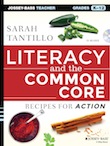The Gr-2 ELA Standard You May Need to Teach

I know we’re probably not supposed to have favorites when it comes to the Common Core Standards, but I do. I fell in love with Reading Informational Text (RIT) Standard #2.1 one day when a group of 3rd grade teachers that I was working with told me that their students had just bombed a test on RIT Standard #3.1 and so they were going to “reteach it.”
“Hang on,” I said, because usually what people mean when they say “I’m going to reteach it” is “I’m going to try the same approach again and hope for the best.”
So we first looked at the third-grade version of the standard (hang with me – this has middle grades application!):
| RIT 3.1 | Ask and answer questions to demonstrate understanding of a text, referring explicitly to the text as the basis for the answers. |
Then I asked them: “Can your students do the second-grade version of this standard?” We looked at it:
| RIT 2.1 | Ask and answer such questions as who, what, where, when, why, and how to demonstrate understanding of key details in a text. |
They said, “Um, no.”
I asked, “What about the first-grade version? Can they do that?” We looked again:
| RIT 1.1 | Ask and answer questions about key details in a text. |
“Yes,” they said. “They can do that.”
So we sat down and created a simple tool for the second-grade standard. This “5W’s and H Organizer Model” enabled them to teach their students how to ask and answer these questions in one sitting. Since then, I have used this same tool (adapted accordingly) with students in other grades as well because, it turns out, many middle and high school students need help with RIT 2.1 too.
I think you’ll see how this would work using age-appropriate reading material for grades 4-8:
Name__________________ Date________
5W’s and H organizer (RIT 2.1)–MODEL
| Question | Answer | |
| Who (name) | Who asks the Grinch why he is stealing her family’s tree? | Cindy-Lou Who asks the Grinch, “Santa Claus, why are you taking our Christmas tree? WHY?” |
| What (thing) | What does the Grinch expect to hear after he steals everything from the residents of Who-ville? | The Grinch expects to hear the residents of Who-ville crying on Christmas morning. |
| When (time) | When does the Grinch realize that he has not stopped Christmas from coming? | The Grinch realizes he has not stopped Christmas from coming when he hears the residents of Who-ville singing happily on Christmas morning. |
| Where (place) | Where does the Grinch live? | The Grinch lives just north of Who-ville in a cave. |
| Why (because) | Why does the Grinch hate Christmas? | No one is really sure why the Grinch hates Christmas, but it’s possible that “his heart was two sizes too small.” Maybe he hates Christmas because he does not have any family or friends to celebrate with. |
| How (by___) | How does the Grinch attempt to ruin Christmas for the residents of Who-ville? | The Grinch attempts to ruin Christmas for the residents of Who-ville by stealing their food, trees, and gifts. |
(Download 5W’s & H Organizer Model.)
Notice how we viewed the Common Core Standards as a skills ladder and targeted instruction to help students climb by directly teaching them the specific skills they needed. No matter what grade or subject you teach, you can use this approach to figure out where your students are.
One day while analyzing the trajectory of the Reading: Informational Text standard from K-12, a 7th-grade teacher remarked: “I have a class of 25 students. I know ten are on the 5th-grade level for this standard, ten are on the 6th-grade level, and five are on grade level.”
She realized she could use her knowledge of where students stood to differentiate instruction, tied to the progression of skills leading up to and including the 7th grade standard – the rungs on the ladder.
[Editor’s note: Find Sarah’s “Common Core Trajectory Analysis,” which shows how to look at a standard across grades, in this earlier MiddleWeb article.]
Some standards are more complex than others

For example, RIT #6.1 — “Cite textual evidence to support analysis of what the text says explicitly as well as inferences drawn from the text” — requires students to paraphrase, ask questions about text, draw inferences, distinguish between argument and evidence, identify evidence relevant to particular arguments, build arguments with relevant evidence and explanation, and cite sources properly.
Students might have skills to do some of those things. Our job is to determine which skills they need help with in order to master the whole standard.
RIT #2.1 is essential and easy to address
The beauty of RIT #2.1 is that it is one of the few standards that students can master more or less in one sitting. The information they need to know is very specific and concrete, and they can see it modeled and practice it immediately. You can tell very quickly if they are “getting it” or not.

No matter what grade or subject you teach, if you have students whose writing is very list-oriented with unexplained evidence, it could mean that they have not mastered this second-grade standard. For those students, try the 5W’s and H Organizer strategy.
Remember that RIT #2.1 is a high-leverage standard. It’s one that – once your students master it –can have a dramatic impact on their reading and writing growth in any grade.




































